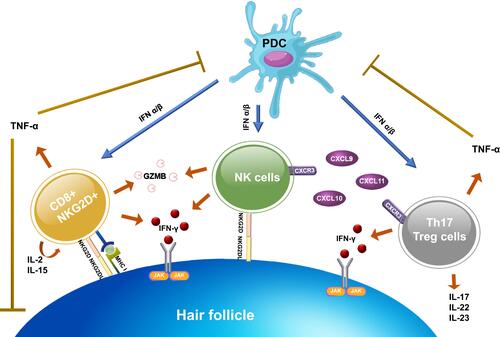Figures & data
Figure 1 Immune system activation in AA. After the NKG2D receptor is recognized by the NKG2D associated ligands (MICA, ULBP3, and ULBP6), it promotes aggregation of CD8+NKG2D+ T cells. Activated CD8+NKG2D+ T cells mainly produce IFN-γ to upregulate MHC class I and II expression via the JAK-STAT pathway and generate GZMB to induce apoptotic cell death. Concurrently, CD8+NKG2D+ T cells increase an upregulation of γ-chain cytokines (IL-2 and IL-15), which create a positive feedback loop by promoting the activation of IFN-γ–producing CD8+NKG2D+ T cells. NK cells and CD4+ T cell subtypes (Th17 and T reg cells) also produce IFN-γ. NK cells attack hair follicles upon the binding of NKG2D ligand to NKG2D receptor and through CXCR3 ligands expression (CXCL9, CXCL10, and CXCL11). While CD4+ T cell subtypes, initiated by upregulation of MHC class II, trigger several pro-inflammatory cytokines and chemokines. PDCs play a role in the pathogenesis by producing a large amount of type I IFN to enhance the activation of CD8+, CD4+, and NK cells. However, TNF-α, created by CD4+ and CD8+ T cells, also have negative effects by suppressing PDCs activity and interfering with the keratinocytes differentiation.

Table 1 Pathogenetic Factors and Targeted Immunotherapies of Alopecia Areata
